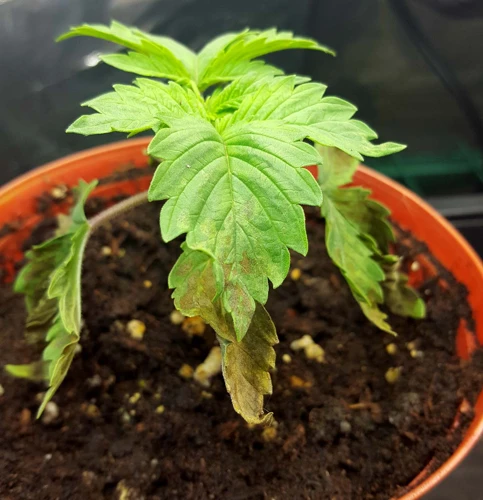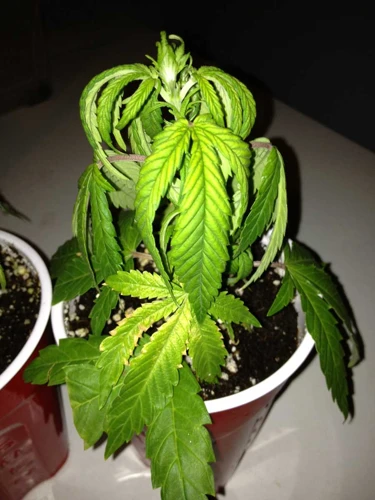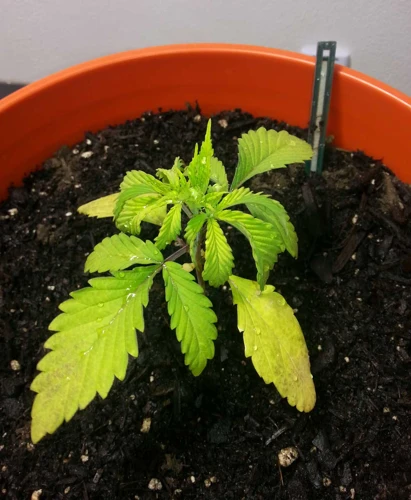
Overwatering and Underwatering Cannabis Plants
Cannabis plants are known for their resilient nature, but like all living things, they require the right amount of care to thrive. However, it can be challenging to know how much water your cannabis plants need. Overwatering and underwatering are two common mistakes made by many growers. Overwatering can drown the roots and cause mold, while underwatering can lead to dehydration and slowed growth. In this article, we will discuss the effects of overwatering and underwatering on cannabis plants and provide practical tips for identifying and preventing these issues.
What is Overwatering?
Contents
Growing healthy cannabis plants requires adequate watering, but too much of a good thing can be harmful. Overwatering is a common mistake made by novice gardeners that involves providing cannabis plants with more water than they need. This can lead to a wide range of problems including root rot, mold, and stunted growth. In this section of the article, we will explore what overwatering is, how to identify it, and how to fix it. If you want to learn more about proper watering techniques, check out our top 5 tips for watering cannabis plants.
How to Identify Overwatering
To identify overwatering in cannabis plants, there are several signs you need to look out for:
- Yellowing leaves: One of the most common signs of overwatering is yellowing leaves. When plants are overwatered, the roots become saturated and can’t absorb oxygen. This causes the leaves to turn yellow and eventually die off.
- Wilting: Believe it or not, overwatering can cause wilting just like underwatering. If the roots are waterlogged, they can’t take up nutrients properly, which can cause the plant to wilt.
- Mushy roots: Another sign of overwatering is mushy or slimy roots. This is because the roots are drowning in excess water, and as a result, they start to rot.
- Fungus gnats: Overwatering can also attract fungus gnats. These small flies love moist soil, and if you’ve got an infestation, it could be a sign that you’re watering your plants too much.
It’s important to note that not all of these symptoms will appear at once, and some may appear differently depending on the strain of cannabis you’re growing. However, if you notice any of these signs, it’s best to take action and adjust your watering habits accordingly.
Fixing Overwatering
If you suspect that you have overwatered your cannabis plants, don’t panic! There are several steps you can take to fix the issue and prevent further damage to your plants. Here are some steps you can follow:
1. Stop watering immediately: The first step to fixing overwatering is to stop watering your plants immediately. Excess water can quickly lead to root rot, which can be lethal to your cannabis plants.
2. Check the drainage system: It’s important to check the drainage system of your container and ensure that it’s functioning properly. If there is no way for excess water to drain out, it will sit in the soil and suffocate the roots. Make sure that there are enough drainage holes at the bottom of the container and that they are not clogged with soil or debris.
3. Increase air circulation: Overwatered plants often suffer from poor air circulation, so it’s important to increase the airflow around your plants. You can do this by placing a fan near your plants to improve air circulation and reduce humidity levels.
4. Remove the topsoil: If the soil is completely waterlogged, remove the top layer of soil (around 2-3 inches) with a trowel or your hands to expose the damp soil underneath to the air. This will allow the soil to dry out faster and prevent further water retention.
5. Adjust watering schedule: Once your plants have recovered from overwatering, it’s important to adjust your watering schedule accordingly. In general, cannabis plants need water when the top inch of soil feels dry to the touch. Use this as a guideline for when to water your plants and avoid overwatering them in the future.
By following these steps, you can fix overwatering and prevent it from happening again in the future. Remember to give your plants time to recover and adjust your watering schedule accordingly for healthy and happy plants.
What is Underwatering?
While overwatering is a common mistake made by cannabis growers, underwatering also presents its own set of challenges. Underwatering occurs when a plant does not receive enough water to sustain its growth and development. This can lead to a variety of issues, such as stunted growth, wilting leaves, and even death. It’s important to understand the signs of underwatering and how to address the issue to ensure the best possible growth for your cannabis plants.
How to Identify Underwatering
When a cannabis plant is underwatered, there are several signs that can help you identify the issue. Here are some of the key indicators:
| Dry Soil: | The soil will be dry to the touch, and the pot will feel light when you pick it up. |
| Yellowing Leaves: | The leaves may start to turn yellow, and may also become brittle and crispy. |
| Curling Leaves: | The leaves may curl upwards, as the plant tries to conserve moisture. |
| Drooping Leaves: | The leaves may droop downwards, and may also feel dry and papery to the touch. |
| Slow Growth: | Your plant may not be growing as quickly as it should, and may appear stunted or small compared to other healthy plants. |
It’s important to keep a close eye on your cannabis plants and check their soil moisture levels regularly. Underwatering can lead to serious problems if not addressed in a timely manner, so it’s crucial to take action as soon as you notice any of these signs. In the next section, we’ll cover some tips for fixing and preventing underwatering.
Fixing Underwatering
When a cannabis plant is underwatered, it means that it’s not receiving enough water to thrive. If this issue is not addressed promptly, it can negatively impact the plant’s growth and overall health. Here are some steps you can take to fix underwatering:
| Step | Description |
|---|---|
| 1 | Water the plant immediately. |
| 2 | Give the plant enough water to saturate the soil. |
| 3 | Make sure the pot has drainage holes to avoid waterlogging the plant. |
| 4 | Wait until the top inch of soil is dry before watering again. |
| 5 | Consider adding a layer of mulch on top of the soil to reduce evaporation and retain moisture. |
| 6 | Avoid overcompensating for the lack of water by giving the plant too much at once, as this can lead to overwatering. |
By following these steps, you can help your underwatered cannabis plant recover and grow to its full potential. It’s important to monitor the soil moisture levels regularly and adjust your watering schedule accordingly to prevent underwatering in the future.
The Effects of Overwatering and Underwatering on Cannabis Plants
It’s no secret that proper watering is essential for the healthy growth of cannabis plants. However, both overwatering and underwatering can lead to detrimental effects on these plants. That’s why understanding the impact of these two watering extremes is crucial. In this section, we’ll explore in detail the consequences of overwatering and underwatering on cannabis plants, including how they can affect plant growth, yield, and overall health.
Overwatering and Cannabis Plant Growth
Overwatering can have a detrimental effect on the growth of cannabis plants. When cannabis plants are overwatered, their roots become suffocated and start to rot. This can lead to stunted growth and reduced plant health. Additionally, overwatering can lead to nutrient lockout, which means that the plant is not able to absorb important nutrients from the soil.
The Effects of Overwatering on Cannabis Plants
| Effect of Overwatering on Cannabis Plants | Explanation |
|---|---|
| Root Rot | Overwatering causes the roots to become waterlogged, which can lead to root rot. This makes it difficult for the plant to absorb water and nutrients, and can ultimately lead to the death of the plant. |
| Stunted Growth | When the roots are unable to properly absorb water and nutrients, the plant may not grow as quickly as it should. This can result in stunted growth, and may also cause the plant to have a weak stem. |
| Yellowing Leaves | Overwatering can cause the leaves of the cannabis plant to turn yellow, as the plant is unable to absorb the nutrients it needs to grow. This can also be a sign of nutrient lockout. |
| Mold Growth | When there is too much moisture around the roots of the cannabis plant, it can create the ideal environment for mold to grow. This can cause the plant to become sick and may even lead to the death of the plant. |
How to Fix Overwatering
If you have overwatered your cannabis plant, it is important to take action to prevent further damage.
- Stop watering the plant immediately and allow the soil to dry out completely.
- Remove any standing water from the container or saucer.
- Check the plant for signs of root rot or mold and remove affected areas.
- Re-pot the plant into fresh, well-draining soil that does not contain any moisture-retaining elements like perlite or vermiculite.
Preventing Overwatering
To prevent overwatering, it is important to monitor the soil moisture levels and only water when the soil is dry to the touch. Here are some tips for preventing overwatering:
- Use well-draining soil that allows excess water to drain away from the roots.
- Avoid containers with no drainage holes, as these can trap excess water around the roots.
- Only water the plant when the soil feels dry to the touch.
- Avoid watering the plant on a set schedule, as this can lead to overwatering.
Underwatering and Cannabis Plant Growth
When it comes to underwatering, the effects on cannabis plant growth can be just as detrimental as overwatering. If a plant is not receiving enough water, it becomes thirsty and stressed which can negatively affect its overall development and yield. Here are some of the potential effects of underwatering cannabis plants:
- Stunted Growth: One of the most obvious signs of underwatering is stunted growth. When a plant doesn’t have enough water, it can’t properly photosynthesize and grow to its full potential. This can result in a smaller plant with fewer branches and leaves.
- Dry and Brittle Leaves: Another sign of underwatering is dry, brittle leaves that are brown at the edges. This is because the plant is not receiving enough water to keep its leaves hydrated and healthy.
- Increased Susceptibility to Pests and Diseases: When a plant is stressed due to underwatering, it becomes more vulnerable to pests and diseases. This is because the plant’s immune system is weakened, leaving it more susceptible to attacks from pests and diseases.
- Poor Flower Development: If a cannabis plant is not receiving enough water, it will have a difficult time producing flowers. This is because flowers require energy to develop and without enough water, the plant may not have the energy it needs to produce big, healthy flowers.
- Lower Yield: Ultimately, if a cannabis plant is not receiving enough water, its yield will suffer. The plant may produce smaller buds or fewer buds overall, resulting in a lower yield.
In order to prevent the negative effects of underwatering, it’s important to make sure your cannabis plants are receiving enough water. This can be achieved by monitoring the moisture levels in the soil and watering the plants whenever the soil feels dry to the touch. However, it’s important not to overwater as well, as this can lead to a whole other set of issues. Finding the right balance when it comes to watering your cannabis plants is key to promoting healthy growth and maximizing your yield.
Preventing Overwatering and Underwatering
Ensuring that your cannabis plants get the right amount of water is crucial to their growth and overall health. Overwatering and underwatering can both be detrimental to your plants. But how do you prevent these issues from occurring in the first place? In this section, we’ll explore different strategies you can use to prevent overwatering and underwatering, from choosing the right soil and container to monitoring soil moisture levels. By following these tips, you can help your cannabis plants thrive and avoid the common pitfalls of improper watering.
Choosing the Right Soil
When it comes to growing healthy cannabis plants, choosing the right soil is crucial. The soil you choose will impact your plant’s overall health, growth, and yield. Here are some factors to consider when choosing the right soil for your cannabis plants:
| Type of Soil | Description |
|---|---|
| Loam Soil | This type of soil is a combination of sand, silt, and clay, making it ideal for cannabis plants. Loam soil provides excellent drainage while retaining moisture and nutrients. It also provides a stable structure for root growth. |
| Clay Soil | This type of soil is rich in nutrients, but has poor drainage. It can also become compacted, making it difficult for roots to penetrate. Adding organic matter, such as compost or perlite, can help improve drainage and soil structure. |
| Sandy Soil | This type of soil has excellent drainage, but it does not hold onto moisture or nutrients well. It’s important to add organic matter to sandy soil to improve its water and nutrient retention. |
| Peat Moss Soil | This type of soil is rich in organic matter and retains moisture well. However, it can become acidic over time, which can harm your cannabis plants. It’s important to monitor pH levels and adjust as necessary. |
In addition to the type of soil, it’s important to consider the soil’s pH level, as cannabis plants prefer a slightly acidic pH between 6.0 and 6.5. You can test soil pH levels with a pH testing kit, which can be purchased from a gardening supply store.
When choosing soil for your cannabis plants, make sure to avoid soils that contain chemical fertilizers, as they can harm your plants and impact the flavor of the buds. Instead, look for organic soil that is made from natural materials and free from harmful chemicals.
Choosing the right soil for your cannabis plants is crucial for their health and growth. Take the time to research different soil options and consider your plant’s individual needs to ensure optimal results.
Picking the Right Container
Choosing the right container is crucial in preventing overwatering and underwatering of cannabis plants. Here are some tips to consider when selecting a container for your cannabis plants:
- Drainage holes: Ensure that the container has enough drainage holes to allow excess water to escape. This will prevent water from accumulating at the bottom of your container, which can lead to root rot and overwatering.
- Size: The container size should be based on the size of your cannabis plant. A container that is too small will limit growth and can cause underwatering, while a container that is too large can lead to overwatering. Typically, a container that is double the size of the plant’s root ball is a good rule of thumb.
- Material: The material of the container can also impact water retention. Plastic containers retain water more than porous material like fabric pots. Consider the climate where your cannabis plant will be grown and choose a material that will suit the plant’s needs.
- Handles: It’s helpful to choose a container with handles for ease of movement and transportation. However, be cautious when moving containers as they can be heavy and cause damage to the plant’s root system.
By following these tips, you can ensure that your cannabis plants are growing in the proper container for their needs, and you can avoid the negative effects of overwatering and underwatering.
Monitoring Soil Moisture Levels
Properly monitoring soil moisture levels is crucial to avoid overwatering or underwatering cannabis plants. One effective way to do this is by using a moisture meter. A moisture meter measures the amount of moisture present in the soil and provides an accurate reading of the soil moisture levels. You can find moisture meters at any gardening store or online.
Here are some tips on how to use a moisture meter:
- Insert the probe of the moisture meter into the soil until it reaches the root zone.
- Take readings in different areas of the container or grow bed. This will help you determine if the moisture level is uniform or if there are areas with different moisture levels.
- Record your readings and keep a log of the moisture level. This will help you establish a watering routine.
- Take readings at various times of the day. Moisture levels can change throughout the day depending on factors such as temperature, humidity, and airflow.
Remember, the goal is to maintain consistent moisture levels, not to keep the soil wet at all times. Overwatering can lead to root rot, while underwatering can cause the plants to wilt and stop growing. By monitoring soil moisture levels regularly, you’ll be able to water your cannabis plants as needed and provide them with optimal growing conditions.
Conclusion
In conclusion, it is essential for cannabis growers to understand the importance of proper watering techniques to ensure healthy plant growth. Overwatering can cause root rot and suffocate the plant roots, leading to stunted growth or death. Underwatering, on the other hand, can cause dehydration and nutrient deficiency, leading to similar growth problems.
To prevent overwatering and underwatering, it is crucial to choose the right soil and container for your cannabis plants. The soil should have proper drainage capabilities, while the container should have drainage holes to allow excess water to escape. Growers should also monitor soil moisture levels regularly to ensure that the plants are receiving the appropriate amount of water.
By following these tips, cannabis growers can avoid the negative effects of overwatering and underwatering their plants and achieve the desired yields. Remember that watering can have a significant impact on the overall health of your cannabis plants, so take the time to establish a proper watering routine for optimal results.
Frequently Asked Questions
How often should I water my cannabis plants?
It depends on several factors like the size of the container, the type of soil, and the stage of growth. Generally, you should water your plants when the top inch of the soil feels dry.
Can overwatering kill my cannabis plants?
Yes, overwatering can lead to oxygen deprivation in plants, which in turn can cause the roots to rot, leading to death.
Can underwatering harm my cannabis plants?
Yes, underwatering can cause the leaves and stems to become wilted, and if left unaddressed for too long, it can result in plant death.
How can I tell if my plant is being overwatered?
Signs of overwatering can include yellowing leaves, dropping leaves, slow growth, and mold or fungal growth on the soil.
What are the symptoms of underwatering?
The signs of underwatering include dry, crispy leaves that may turn yellow or brown and wilted stems.
Can I fix an overwatered plant?
Yes, you can fix an overwatered plant by allowing the soil to dry out and adjusting your watering schedule in the future.
How can I fix an underwatered plant?
You can fix an underwatered plant by watering the plant until the soil is moist but not waterlogged and ensuring that you water it regularly after that.
What are the effects of overwatering on plant growth?
Overwatering can lead to stunted growth, reduced yields, and nutrient deficiencies in plants.
How does underwatering affect plant growth?
Underwatering can cause the leaves to become brittle and yellow, reduce the plant’s overall growth, and affect the plant’s ability to produce flowers and fruits.
What can I do to prevent overwatering and underwatering my plants?
You can prevent overwatering and underwatering by choosing the right soil, container, and monitoring soil moisture levels regularly. It’s also important to establish and maintain a regular watering schedule.





